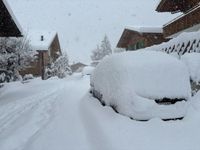Heavy rain and snow have wreaked havoc across the Alps, particularly affecting southern Switzerland and northwestern Italy. The extreme weather conditions have resulted in power outages, closed roads, and a high risk of avalanches, prompting authorities to issue a code red alert in the affected areas.
In parts of Northern Italy, over 500 mm of precipitation has been recorded since Tuesday morning, April 15, 2025, equating to several months' worth of rain in just a few days. The snow line has plummeted to below 500 meters in some valleys, with heavy snowfall accumulating at higher altitudes, creating treacherous conditions for travelers and locals alike.
In the Swiss canton of Wallis, rainfall has reached up to 200 liters per square meter, combined with significant snowfall at higher elevations. The avalanche danger has risen to level 4, indicating a high risk, with avalanches potentially reaching inhabited areas. Numerous roads, passes, and railway lines have been completely closed, including the famous railway line between Visp and Zermatt, as well as the Simplon Pass, Simplon Tunnel, and Great St. Bernard Pass.
In Italy, the situation is similarly dire, with multiple roads closed and several villages experiencing blackouts due to power outages. As a precautionary measure, all schools in Wallis have been closed, and warnings for flooding have been issued due to rising water levels in rivers such as the Rhône.
Travelers looking to enjoy winter sports are strongly advised to reconsider their plans, as many ski resorts have shut down lifts and access roads, placing additional strain on emergency services. Potential visitors are encouraged to check with local tourism offices regarding current conditions before heading to the affected areas.
Weather forecasts indicate that the severe conditions are expected to persist through Thursday evening, April 17, 2025. Following this, while the immediate weather may stabilize, the aftermath—including landslides, flooding, and avalanches—could pose risks for days to come.
Images emerging from the Alpine region depict the dramatic impact of this weather system, with scenes of heavy snowfall and flooding that were rarely seen in recent winters. The situation is particularly alarming in the extreme northwest of Italy and the south of Switzerland, where weather stations have reported unprecedented precipitation levels.
In fact, some areas have already received more than 2 meters of snow, leading to closures of ski areas, roads, and tunnels due to the extreme avalanche risk. Supermarkets have also shut down to prevent food spoilage, as many areas are grappling with significant power outages.
As the emergency response continues, Swiss and Italian fire departments are working tirelessly to keep roads accessible amidst falling trees and hazardous conditions. The ongoing weather crisis has led to alarming reports of flooding and landslides, particularly in lower-lying areas.
The Po River, for instance, has reached a critical water level of 5.50 meters, triggering an alarm phase, with levels now rising to 7 meters and expected to continue increasing. Residents in the vicinity are being urged to prepare for potential flooding.
Despite the chaos, the heavy precipitation is a boon for the glaciers, which have suffered in recent years due to climate change. However, the immediate dangers posed by the current weather system have overshadowed these long-term benefits.
As the Alpine regions brace for continued snowfall and rain, the impacts on local communities, tourism, and infrastructure are becoming increasingly apparent. Authorities are urging everyone to remain vigilant and prioritize safety in these challenging conditions.
In summary, the Alps are currently experiencing a severe weather event that has resulted in significant disruptions and dangers, with heavy snowfall and rainfall leading to power outages, closed roads, and a heightened risk of avalanches. The situation remains fluid, and residents and travelers alike are advised to stay informed and cautious as they navigate the aftermath of this unprecedented weather.





